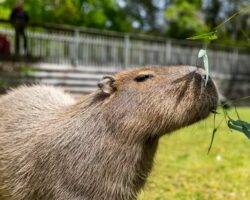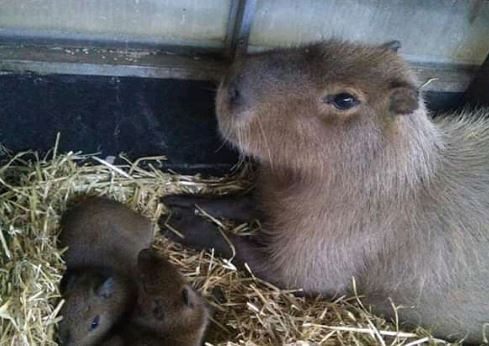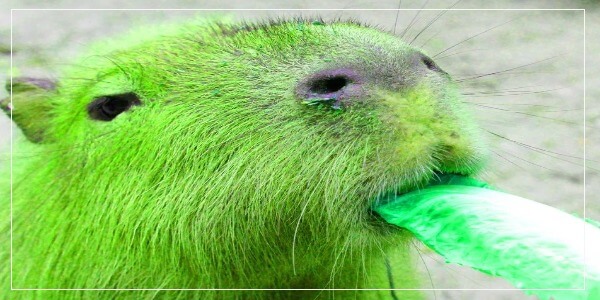Just as for us, it is exhausting for animals to walk around all day. To relax and ease stress, some sit while others lie down. But some prefer to sit on other animals.
The capybara is one animal that doesn’t mind being sat on. This post discusses which animals sit on it and why they get along so well.
Can Animals Sit On Capybara?
Time after time, capybaras have proved that they are very social animals. Of course, ants are social, termites too, but the Capybara’s social scope goes beyond their species.
Capybaras are so social they allow other animals to sit on their backs. They even enjoy it! This is helped by the barrel-like back of the rodent, which provides enough room for animals to sit.
All over the Internet, you will find pictures of capybaras hanging out with other animals, using them as bed rests. This is the reason they are called “nature’s ottomans” or “living cushions.”
Which Animals Like Sitting on Capybara
Capybaras are cool with most animals. But not everyone is qualified for a piggyback. Usually, bigger animals than the capybara are not encouraged to “hop on” and enjoy the view.
Spider Monkeys Sitting On Capybara
Naturally, this relationship should not have been. In the wild, spider monkeys live in mahogany trees forty feet high in the tropical rainforest, while capybaras stay near the river bank.

But anytime these animals cross paths, you can see the chemistry between these animals. Their friendship is magnificently cute. The Capybara gives back rides to the monkeys, sometimes when it needs to cross the rivers and other times when it’s just being playful.
Squirrel Monkeys Sitting On Capybara
Like their monkey cousins, squirrel monkeys love sitting on capybaras too. They also hitch rides and use the capys to cross rivers.
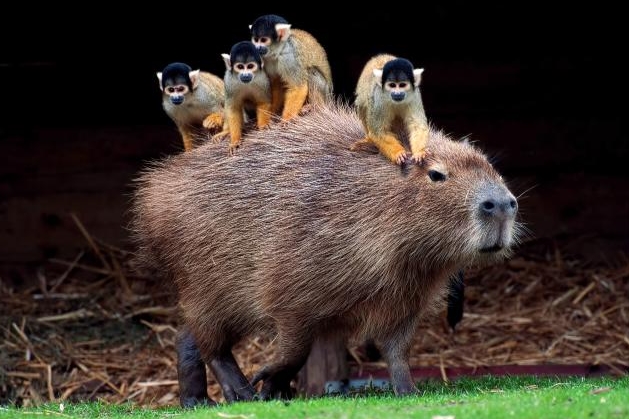
Ducks Sitting On Capybara
They share the bank with the rodents; thus, the a higher chance that capybaras and duck’s paths would cross than the monkey cousins. But if you think the rodent would attack the bird because it’s bigger, you will be disappointed.

Capybaras love ducks! They let them perch on their backs while they rest. They don’t need them to cross the river; ducks are excellent swimmers.
Turtles Sitting On Capybara
Even if their mothers didn’t show them any parental care, Capybaras would. These rodents are lovely to a fault. If they want to, capybaras will cuddle with turtles and allow them to sit on their backs.
This capybara is surrounded by a turtle-ish guard of honor!
Chickens Sitting On Capybara
Domesticated capybaras are known to form partnerships with pets. While they can bond with your cats or dogs, they do not discriminate against chickens.
Chicken (especially chicks) love to sit on them while they rest, and the rodent doesn’t mind. Here is a particular capybara pictured rocking a chicken!
Magpies Sitting On Capybara
Loud and chattery, even magpies enjoy Capybara’s company. Like the duck, this bird perches on the rodent’s back and helps itself to insects on its fur.
Capybaras enjoy this since the bird’s beak feels like a massage. It’s a win-win for everyone. Does anyone care for lunch and a massage? Yes, please!
Egrets Sitting On Capybara
Same as they have with cattle, egrets enjoy a symbiotic relationship with capybaras. Feeding insects and ticks on their body, the capybara provides the egrets’ food and company while the birds rid their fur of insects and other parasites.
Other Capybaras
It’s common for a larger capybara to allow other capybaras to sit on it. Youngsters are cared for in groups and can sit on their mothers in turn.
This bonding is necessary for both parents and offspring, and it is a regular event. Unless they are eating or need to swim, youngsters usually cuddle their moms or other moms in the group and sit on their backs.
RECOMMENDED FOR YOU:
Why Do Animals Sit On Capybaras?
The major reason is their calm and laid-back attitude. Capybaras are known to tolerate other animal tricks and silliness. They (almost) never get angry. They never lash out. They never complain and even position themselves to serve other animals.
They are like a butler, serving the old English family as a chauffeur, ushering the wealthy boss into the limo. As long as they are not hurt, they don’t care what other animals do around them.
Sometimes, they seem to enjoy their silliness! Other animals see them as perfect playing partner!
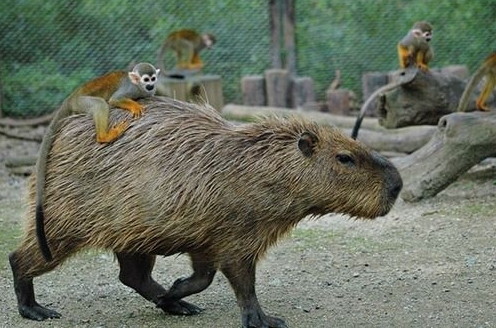
Another point is that Capybaras like to be touched. They don’t mind sharing space with other animals just to be touched. After food and water, being touched are high up in the importance of their needs.
Other animals appreciate their calmness and climb on their backs. They have understood that capybaras like to be touched, and it gives them pleasure to be around other animals.
So they climb on their backs, sit there and take a ride and relax. They even peck their backs or kiss them! All is well appreciated! All in the day’s job for a capybara!
Do Capybaras Hurt Animals Sitting on Them?
Possessing sharp, constantly growing teeth, capybaras bites are painful. It is, however, rare for a capybara to attack other animals. Except it is threatened. And it is in danger.
Animals that sit on Capybaras are smaller than their size, and if it wanted to hurt them, they would pose little challenge, which is uncommon. Animals that sit on capybaras are not usually hostile to them. They are only trying to hitch a ride or socialize.
Aside from that, Capybaras seldom attack, nor do they like to, oftentimes. They are defensive animals. They prefer fleeing into the safety of the river to fighting. So they won’t hurt the animals sitting on them as long as they are not threatened.
How Long Can Animals Sit On Capybaras?
Capybaras are considerate animals. When an animal sits on it, it can stay put for hours, accommodating its visitors. They don’t feel much weight, so they stay still.
But eventually, the rodent would need to eat or take a swim. Most of the capybaras’ friends don’t like water, so they must get off when it wants a bath. Some animals don’t mind, though.
Capybaras swim with their head out of the water because they need to breathe. Of course, they can go below water for a few minutes.
Birds such as Magpies can land on their head and neck, and trust the dear Capybara won’t complain! Capybaras swim about six or seven times daily, and they can stay in the water for hours.
How long can the animals sit? This depends on the preference of the animal and if it doesn’t mind getting its fur or feathers wet.
Can Capybaras Withstand Animals Sitting on Them?
Yes, they can! It’s not like they carry elephants!
They usually carry smaller animals, a fraction of the size and weight of their bodies. So if it’s conveying their friends across the river or chilling out, or posing for the perfect picture, capybaras don’t feel stressed.
If they were to piggyback a rhinoceros now, that would be interesting. As their friends jump on their backs, they lay in the grass, take in the scenery, and enjoy whatever silliness they have in store.
Do Capybaras Feel Hurt When Animals Sit On Them?
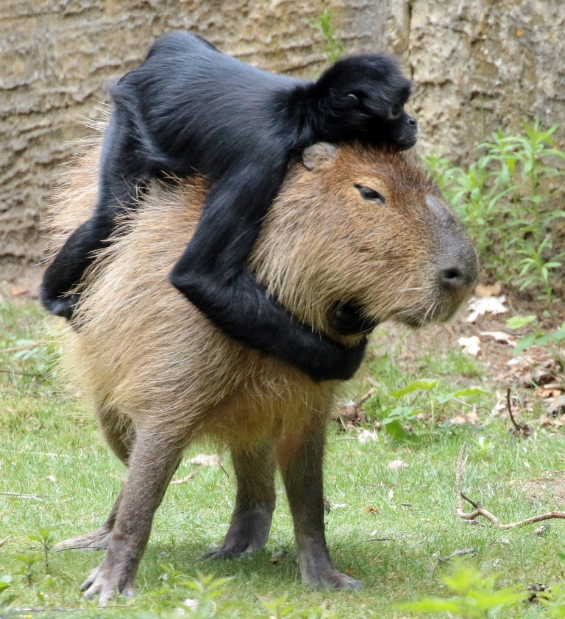
Judging from how long capybaras allow other animals to sit on them, it’s clear they don’t feel any pain. They are not hurt. This goes back to the weight/ size fraction. Capybaras carry lighter animals, so they don’t feel the weight pressure.
We can also conclude from how cute and collected they look when another animal sits on them. They would react if they were distressed or in pain, would react, won’t they?
They might shove the animal or groan, or bark. Yes, a capybara can bark like a dog. They are very vocal animals. You can see them “conversing” with their kind very often.
Even if they were, capybaras are not complainers; they just lay back, relax, and have fun. Any animal willing to stay is welcome to spend as long as they desire.
Why Do Capybaras Allow Animals to Sit On Them?
Capybaras have a strong desire to socialize. Be it with their kind or with other animals. They love to hang out in groups, eating and swimming together.
Their need to socialize is compulsive. Studies have shown capybaras to be genuinely distressed when lonely. They can suffer heartbreak, so to speak. This need, this urge to socialize, prompts Capybaras to allow animals to sit on them.
They interact with other animals by hanging out and filling that social void. It is only then they are contented. They cuddle their young and take group lessons. They offer their backs as boats for monkeys and enjoy grooming sessions from birds.
They are also known to be helpful beyond measure. They are so generous they have been reported to adopt the young of other animals and raise them as theirs.
Has a Capybara Ever Hurt an Animal Sitting on It?
It’s not in the Capybara’s nature to attack animals sitting on it or any animal. This rodent is docile, almost cow-like. Give a capybara grass to chew, water to swim, and others to socialize with, and it’s having the best time of its life.
But there have been incidents when capybaras bit other animals, including humans. An incident occurred in a Canadian zoo when a capybara mulled a monkey to death.
The capybara was separated from its family to be studied. Scientists were interested in why it would turn violet of a sudden. When it remained docile throughout the study, it was concluded that the monkey must have attacked the capybara.
These rodents love monkeys but can attack wherever they are in danger. It is their defense mechanism. This is understandable since these rodents are native to South America, where large carnivores such as pythons and pumas prey on them.
Like a cow, they don’t turn violent until they are threatened. Even that, they don’t attack suddenly. The Capybara must have tried its best to have accommodated all the monkey’s tricks. Until it couldn’t any longer and attacked.
Those sharp front teeth are not for only chewing, after all.
SEE THIS: Can You Ride a Capybara?
Do Capybaras Sit On Other Animals?
We do know that capybaras like carrying other animals, but are the feelings mutual? Do they love to sit on other animals as much as they carry others?
Capybaras sit on their parents when they are young, so they also derive a sense of pleasure from sitting on animals. But as they grow and become bigger, they can’t sit on their fellow capybaras or other animals.
They can’t sit on other capybaras because of their weight, and other animals, though, can take their weight; not many would appreciate being sat on. Imagine an animal sitting on a crocodile.
So yes, capybaras don’t sit on other animals, but they would love it if they had the opportunity. They would not pass over any chance to socialize.
Do Capybaras Take the Animals for a Ride?
Capybaras can hop and are usually fast for their size and structure. But do they take their visitors for a joy ride? Probably not! At best, they can help them cross rivers, but that won’t qualify as a joy ride.
They have not been known to be very excited, prancing, or hopping in delight. They are just docile animals who enjoy a quiet life.
Can Humans Sit On Capybaras?
As an adult, you are bigger and weigh more than a capybara. It would be cruel to sit on it. A child, on the other hand, would be perfect.
Parents and guardians are warned. No matter how friendly the capybara is, it is still a wild animal, and it misunderstands the rough play a child is subjected to, it can bite.
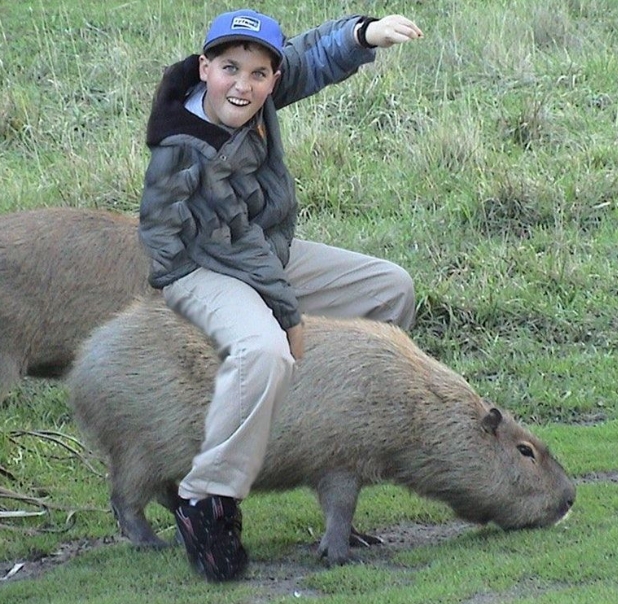
If a child must sit, he or she should stay still and be watched by an adult. Capybaras would enjoy a child’s company, but watch out, parents.
Here’s a recap of what we have learned:
- Capybaras don’t mind other animals sitting on them. They enjoy it. These animals can include monkeys, Magpies, ducks, and other capybaras.
- Their need to socialize is why they allow other animals to sit on them.
- Other animals prefer them because they are docile and seldom complain.
- They rarely attack their companions but can do it if threatened or facing danger. Generally, they flee than fight.
- Capybaras don’t feel hurt when sat on, and they can withstand the weight of their animal friends.
- They would love to sit on other animals if they are allowed.
- An adult human should not sit on it since it cannot take your weight.
- Children should be supervised, always remembering that the capybara is still wild.
Conclusion
Nature has never ceased serving us wonders, and the entire lifestyle of the Capybara is fascinating. So next time you see an egret or a hamster sitting on the capybara, understand that the world’s largest rodent is at home with all its tricks.
They are never offended or unfazed by other animals sitting on them. They encourage and enjoy it.

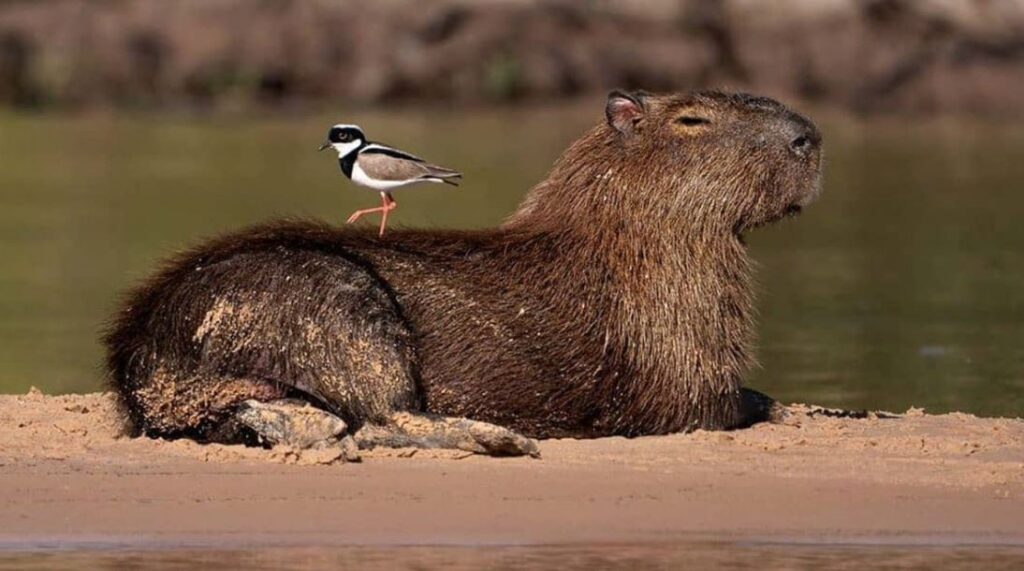
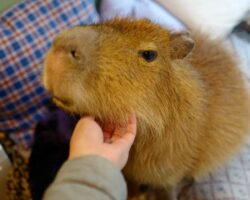
![Capybara Meat And Its Culinary Uses - [Every You Should Know] Capybara Meat & Culinary Uses](https://capybaratips.com/wp-content/uploads/2023/03/Capybara-meat-250x200.webp)



